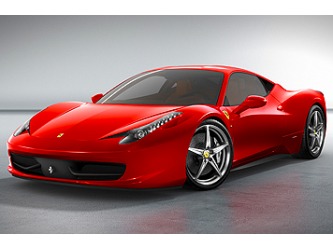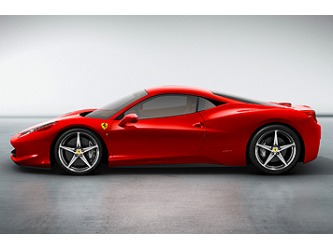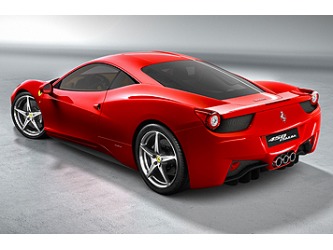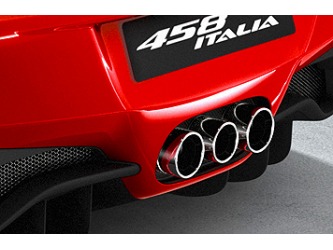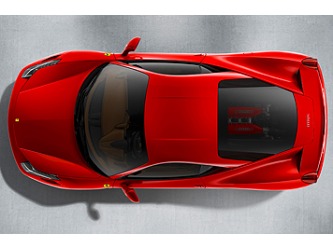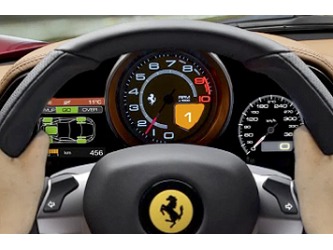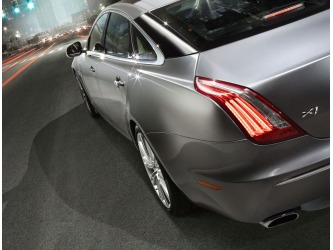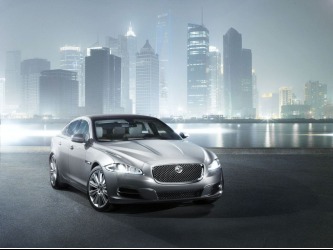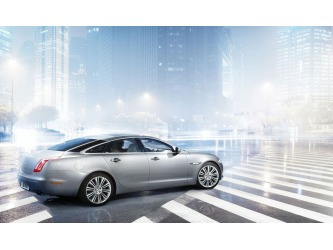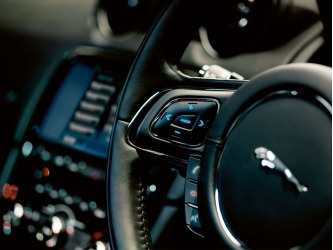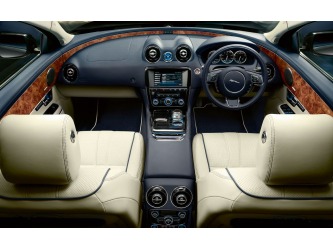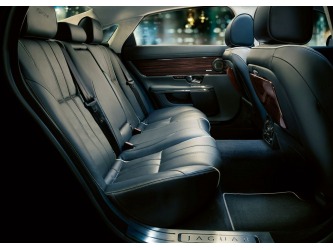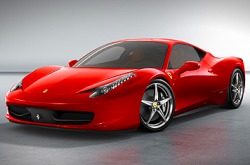 For many months, automotive enthusiasts have been expecting the replacement of the Ferrari F430 to be named the F450, Ferrari today have let us know that it will be named the 458 Italia. Official images have finally been released, and while the car looks completely different to the F430, the overall shape is familiar. But what will really get the Ferrari enthusiast's attention are the triple exhaust outlets at the back, a feature that has been unique to the F40 supercar. As the name of the car suggests, the size of the flat-plane crankshaft V8 engine has increased from 4.3l to 4.5l. The new engine also has a direct fuel injection system. But the big news for the engine is that it now produces more horsepower per litre than any other naturally aspirated production car engine in the world. The record holder used to be the Honda S2000 with 120 hp/l, the 458 Italia snatches the title with 127 hp/l. A power output of 570 hp @ 9000 rpm, means that it is now more powerful than its main rival, the Lamborghini Gallardo LP560-4. However the 458 Italia, produces 540 nm of torque @ 6000 rpm (the same as the Lambo, but at 500 rpm lower), 80 per cent of which is available from 3250 rpm. The Italia will be the second car in Ferrari's line-up to receive a seven speed double-clutch transmission. Ferrari also promises sportier gear-ratios while maintaining the smoothness of a double-clutch gearbox. 0-100 km/h is done in 3.4 seconds (0.6 seconds faster than the F430, and 0.3 seconds faster than the LP560-4). Other important numbers include a top speed over 325 km/h, a dry weight of 1380kg, a weight distribution of 42/58 front to rear, 140 kg of downforce at 200 km/h, a power to weight ratio of 2.42 kg/hp, Co2 emmissions of 320 g/km, and a fuel economy figure of 13.7l/100 km on the combined cycle. Ferrari has also spent time trying to better the new car's handling over the F430. The Italia gets the latest version of the E-diff and F1 Trac system, which now comes with a single ECU as opposed to two from the F430. Ferrari promises quicker accelration out of corners, and better braking thanks to a new system that moves the brake pads closer to the brake discs when you lift off the throttle in order to reduce the delay between stepping on the brakes and the car slowing down. Even though the above pictures are accurate representations of the 458 Italia, all we can do now is wait for Ferrari to reveal this promising new car at Frankfurt's motorshow in August to get a real taste of the Italia. We can't wait. The slight tongue slip from the news reader might make you giggle, but nevertheless, having Bob Lutz remain at GM is good news. 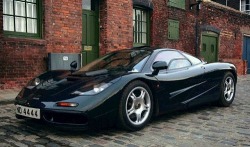 The McLaren F1 to many still remains the ultimate supercar of all time. What with the Bugatti Veyron being tuned to feel like a very high speed saloon, as well as it having all wheel drive and weighing a whopping 810 kg more than the McLaren, it's easy to see why people would see the good old Macca as one of the purest supercars to have ever been built. When it was released in 1994, the F1 came with a 6.1l V12 engine built by BMW, producing an impressive 618 bhp, while torque was rated at 480 lb ft. Combine this impressive power output with a low kerb weight of only 1140kg, and an aerodynamic body shell, the McLaren F1 was able to achieve a mximum speed of over 240 mph. The top speed meant that it was the fastest road car in the world, a title it held onto for 12 years until the arrival of the Bugatti Veyron. So what about the upgrades? We'll begin with the engine. The engine gets a 0.4mm increase in bore, but still remains a 6.1l. The engine also gets lighter pistons, new conrods, modified cylinder heads, new intake and exhaust valves, a raised compression ratio of 12:0.1 from the previous 11:0.1, new camshafts, variable valve timing on both the intake and exhaust side, and a new ECU. This means that power has been raised to 691 bhp (700 PS), but while the increase of engine power might call for a modified gearbox, the one in the McLaren is plenty strong to handle the extra grunt. Another upgrade is the availablity of carbon ceramic brakes. The discs measure 380mm in diameter at the front with 6 pot calipers, while the rear discs measure 320mm with 4 pot calipers. The use of this material has enabled further reduction in unsprung weight by 40kg. Modifications to the chassis include a newly developed adaptive engine mount system which reduces vibrations coming out of the engine bay, and also helps contain the mass of the engine better during cornering. There is also a new adaptive damper system, as well as new 18 inch magnesium wheels and tyres, further reducing unsprung mass. The combination of these chassis modifications guarantee an increase in the cornering capabilites of the F1. Bodywork modifications come in the form of removing the automatic brake and balance aerofoil system, as well as the removal of the active underbody air management system. A total of 63 kilograms have been saved, thanks to all the weight saving measures bringing the total weight of the car down to 1077kg. All of the above mentioned modifications also means that the 0-60 mph time takes a lightning 2.9 secs, the quarter mile can be covered in 10.1 secs @ 144 mph, while top speed is estimated at a Bugatti Veyron-threatening 250 mph. 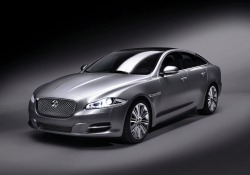 After several months of teaser pics, Jaguar has finally taken the wraps of its Mercedes S Class and BMW 7 series fighter, the XJ. From what we can see from the pictures, Jaguar is continuing with its modern approach towards design. The front end of the car looks very similar to that of the XF model, but as a whole the car looks very fresh and contemporary. Gone are the round headlamps and retro design, that were among the dinstinctive features of previous generation XJ models. The interior is also blessed with a brand new design. It seems a combination of a spacious cabin, high quality leather, good old-fashioned wood, and a modern layout of instruments dominates the interior of the new XJ. Also included in the new XJ is the brilliant rotating gear selector for the six speed automatic transmission. Prices for the new XJ range from £52500 all the way to £88000, depending on the powerplant, options, and wheelbase (Long and standard wheelbases are available). The new XJ can be had with either a 3.0l V6 twin-turbo diesel, a naturally aspirated 5.0l petrol V8, or two supercharged versions of the petrol V8. Important figures for the engines are; 275 hp for the twin-turbo diesel, enabling a 6.0 sec sprint from 0-60 mph, while also returning a respectable fuel economy figure of 40.1 mpg and a Co2 output of 184 g/km. The 385 hp naturally aspirated petrol gets the XJ from 0-60mph 5.4 secs, while a more powerful supercharged version with 470 hp will do it in 4.9 secs. The most powerful engine, though, is the other supercharged 510 hp engine that can also be found in the XFR and XKR. Acceleration to 60 mph takes 4.7 secs. When the XJ goes on sale early in 2010, it will face stiff competition from rivals that dominate the luxury sedan market such as the S-class Mercedes, BMW 7 series, Audi A8, not to mention the gorgeous looking Maserati Quattroporte, and the newly introduced but not so gorgeous Porsche Panamera. But Jaguar brings a good weapon to the game, namely an all aluminium construction. The use of this technology means that the XJ can weigh as little as 1650 kg, which is significantly lighter than its rivals (which also means that it's about 50kg lighter than the smaller steel-bodied XF). A fresh design, being more lightweight than its competitors in combination with Jaguar's skill of making great-handling and fine-riding luxury vehicles, means that people will think long and hard about getting an XJ before going for the default Mercedes or BMW. |
Categories
All
Archives
January 2021
|
